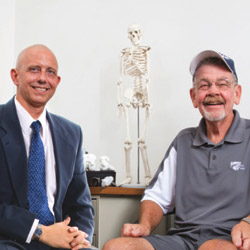
New technologies in knee and hip replacements are leading to better results, faster recovery times and fewer chances of complications.
Custom-Fit for Revolutionary Results
Toby Tyler is one of about 200 central Illinois patients who have recently received the revolutionary knee replacement surgery known as Visionaire Patient Match Technology from Dr. Donald Mitzelfelt of Pekin Orthopedic Center. Dr. Mitzelfelt is among the first surgeons in the area to use this new technology. What makes Visionaire so special is the patient match technology in which the patient’s MRI and x-ray are used to design and create the surgical instruments that perfectly match the anatomy.
“The surgical time is less, blood loss is less, and the result is greater range of motion,” states Dr. Mitzelfelt. “It is groundbreaking—I don’t see a downside.”
Thanks to this new procedure, Tyler was on the golf course playing 36 holes just weeks after his surgery. When you compare the results and recovery to Tyler’s first knee surgery, there is quite a difference. “It’s like night and day,” he said. “It was six months before I could trust my knee, and it was another six months before I could golf on it. I’ve already golfed on this one…There’s no pain involved in it at all.” Tyler’s Visionaire knee has great range of motion and flexibility, and even a smaller scar. “Once the swelling goes down and the staples are out, you are ready to go.”
While every person’s knee joint has subtle differences in shape and contour, traditional surgical instruments used to place knee implants have been one-size-fits-all. In the past, an orthopedic surgeon would spend time during the procedure adapting to a knee’s “terrain” in order to achieve proper placement of the implant. But with Visionaire Patient Match Technology, the surgeon comes to the operating room equipped with single-use instruments, engineered exclusively for that patient’s knee.
Not only does the Visionaire system eliminate multiple steps during surgery, thus reducing time under anesthesia, its computer-guided precision reduces the risk of the kind of misalignment that can cause an implant to wear out before its time. “I have more confidence in the accurate placement of the implant, and my patients benefit from a simplified procedure,” said Dr. Mitzelfelt. “Plus, because the technology delivers pre-sized and pre-aligned instruments, my time in the operating room has decreased significantly. For patients, that means a potentially reduced risk of complications like infection and blood loss.” Visionaire patient-matched instrumentation for knee replacement surgery may be the next step toward rediscovering your active life.
An Alternative to Hip Replacement for Active Adults
Now there's an additional option available for active patients suffering from hip pain. Dr. Mitzelfelt is also one of the few surgeons in central Illinois who are trained and certified to offer this alternative to total hip replacement, called hip resurfacing.
Designed specifically with the active patient in mind, the Birmingham Hip Resurfacing (BHR) system is an alternative to traditional hip replacement that can restore patients to their energetic lifestyles. More bone conserving than a traditional total hip replacement procedure, the hip resurfacing allows the surgeon to shave just a few millimeters of bone and “cap” with an implant (very similar to capping a tooth).
Where traditional total hip replacements involve the removal of the entire femoral head and neck, the hip resurfacing technique simply reshapes the head and leaves the neck untouched. The BHR implant closely matches the size of a patient's natural femoral head (hip ball) and is substantially larger than the femoral head of a traditional total hip replacement implant. This increased size translates to greater stability in the new joint, and it decreases the chance of dislocation after surgery, a leading cause of implant failure after total hip replacement.
Traditional hip replacements often use a metal ball and a plastic socket, which can wear down over time and require surgical replacement. In fact, it is a leading cause of follow-up surgeries. The Birmingham hip implant is an all-metal ball and socket joint, which has proven to wear less than traditional metal on poly bearings.
Hip resurfacing preserves more of the patient's natural bone structures and stability, thereby reducing post-operative risks of dislocation and inaccurate leg length. Plus, the all-metal implant is made from durable, smooth cobalt chrome, which has the potential to last longer than traditional hip implants. "Hip resurfacing is ideal for many of my young, active patients who suffer from hip pain, but aren't ready to give up their active lifestyles," says Dr. Mitzelfelt. "There are patients with resurfaced hips that are able to return to their active, pre-arthritic lifestyles. And, in most cases, they are able to resume their activities faster and with less pain than if they had total hip replacement." iBi

